Capsule Review: EVGA GeForce GTX 780 Superclocked ACX
by Ryan Smith on September 22, 2013 12:00 PM ESTOverclocking
Having taken a look at stock performance, let’s dive into overclocking quickly. Since the 780SC ACX is based on the reference board design it has the same limits as the reference GTX 780 when it comes to overclocking. The max TDP is just 106%, and the max voltage is 1.2v. As a result overclocking headroom won’t be very different from the reference GTX 780, with the ACX cooler and EVGA’s superclocked binning being the only significant differences from a reference card.
| EVGA GeForce GTX 780SC ACX Overclocking | |||||
| Stock | Overclocked | Ref GTX 780 OC | |||
| Core Clock | 967MHz | 1042MHz | 1063MHz | ||
| Boost Clock | 1020MHz | 1095MHz | 1102MHz | ||
| Max Boost Clock | 1123MHz | 1215MHz | 1228MHz | ||
| Memory Clock | 6GHz | 6.8GHz | 7GHz | ||
| Max Voltage | 1.162v | 1.2v | 1.2v | ||
In the end even with binning in play the 780SC ACX isn’t capable of overclocking any higher than our reference GTX 780; in fact it’s a hair worse, with the 780SC ACX topping out at 19MHz less than the reference GTX 780. So from a clockspeed perspective this is a wash. Pushing any higher will require more TDP headroom and more voltage, which in turn will require a fully custom design.
At the same time given the fact that EVGA has already eaten into a lot of the GTX 780’s overclocking headroom with their factory overclock, this means there’s not as much overclocking headroom available for the end user. 967MHz to 1042MHz is still a free 8% increase in clockspeeds; the payoff just isn’t as great as relative to a stock GTX 780.
Moving on, as a result of their similar overclocks, overclocked performance is virtually indistinguishable from our overclocked GTX 780. Despite the ACX cooler keeping temperatures in the low 70s we’re primarily power constrained here, which isn’t something the ACX cooler can help with.
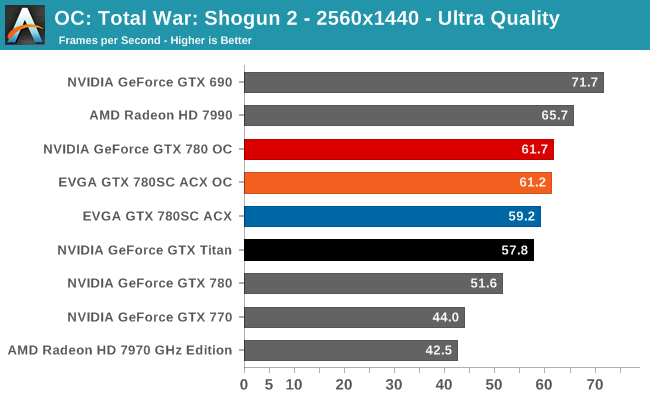
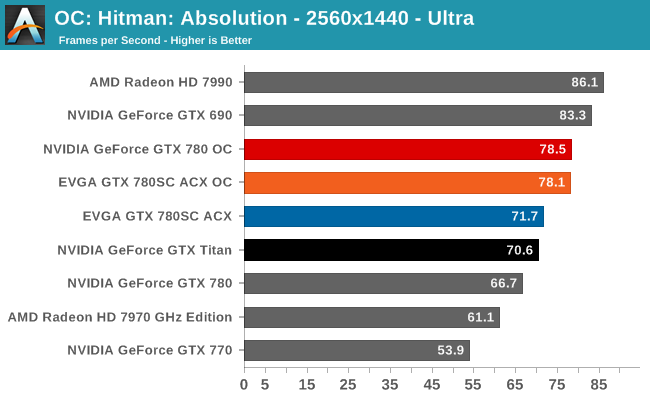
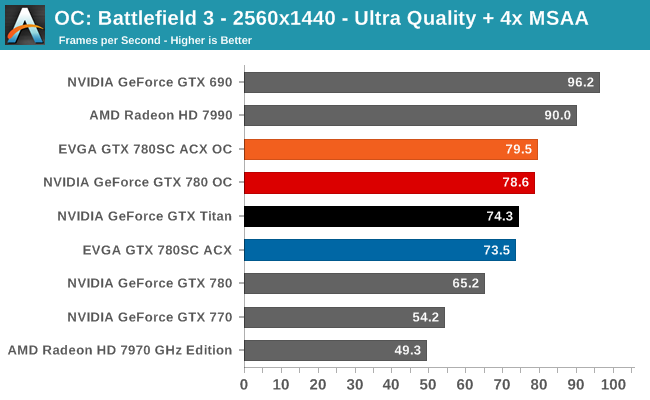
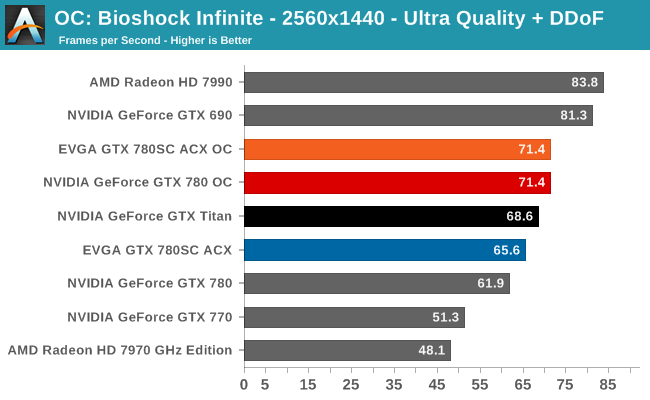
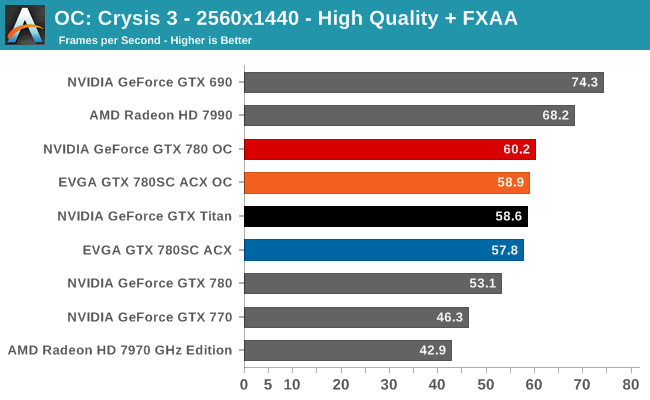
As was the case with overclocking the reference GTX 780, the payoff here is GPU performance that’s well ahead of the GTX 780 at stock, and performance that exceeds even GTX Titan by around 7%.
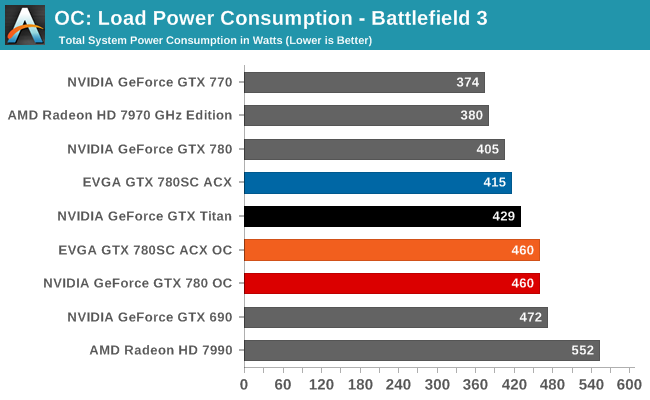
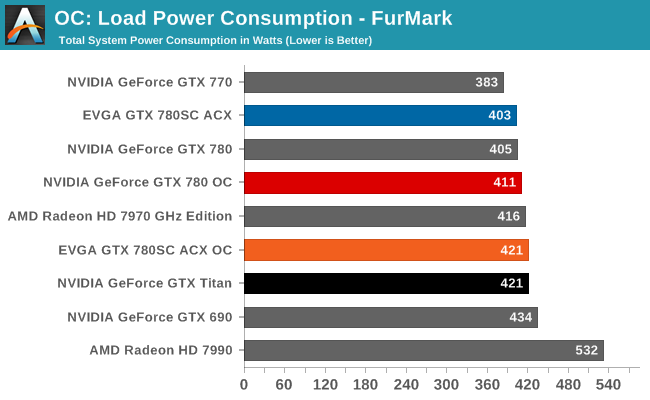
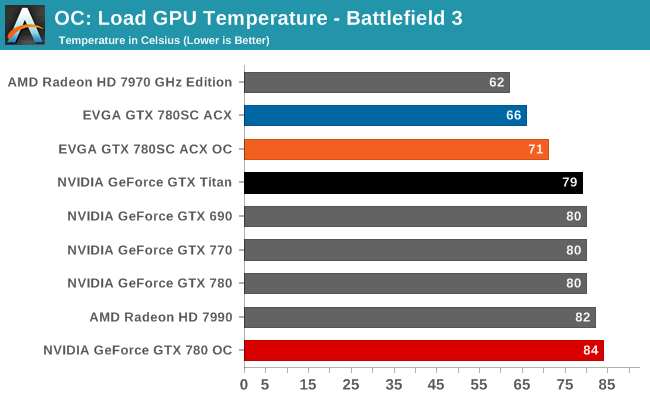

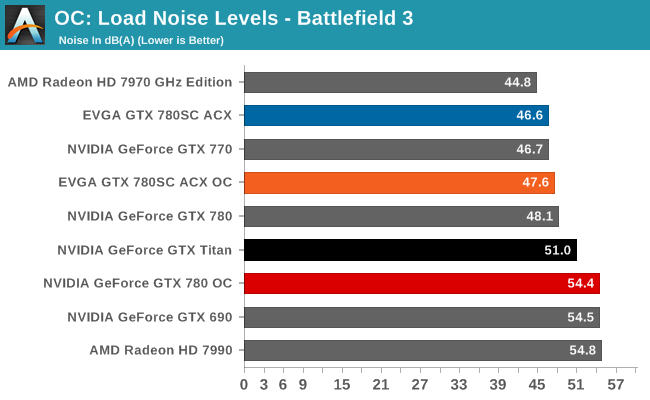
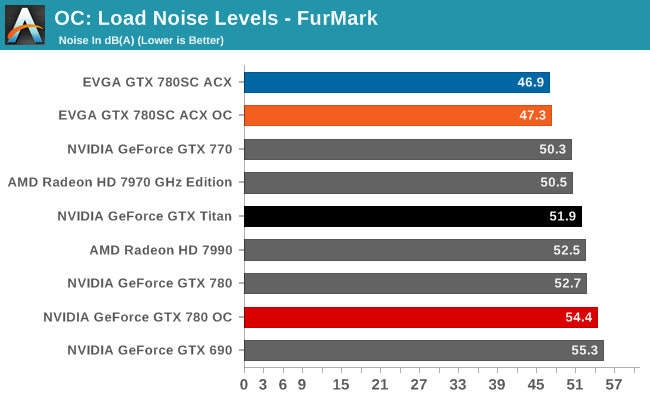
Finally, quickly taking a look at power, temp, and noise after overclocking we can see that the 780SC ACX maintains its strong cooling performance, with temperatures topping out in the low 70s and noise levels rising by just 1dB. The power cost of overclocking is fairly high however, thanks to the use of higher voltage boost bins.
All told, the 780SC ACX’s sweet spot is going to be at stock. While it’s as good an overclocker as any reference GTX 780, the fact that EVGA gives you so much of its overclockability out of the box with a trivial power cost means that the benefits of squeezing out the last bit of headroom don’t pay off quite as nicely here as with a stock card. The ACX cooler will have no problem keeping temperatures and noise levels down however, which means being able to reap the benefits of GTX 780 overclocking without the noise penalty.
Final Words
Wrapping things up, it’s clear that EVGA has put together an extremely solid card with their GeForce GTX 780 Superclocked ACX, both on the basis of performance and relative value. As we alluded to at the start of this article, EVGA is offering a sizable factory overclock for an absolutely tiny price premium, and as a result the 780SC ACX looks extremely good on a price/performance basis. For $10 more than a stock GTX 780 the 780SC ACX delivers 10% better performance, does so with just a trivial increase in power consumption, and ultimately closes the performance gap with GTX Titan. On this basis the 780SC ACX is a much better value proposition than your typical factory overclocked card, to the point where the stock card rarely makes sense. For all practical purposes the stock GTX 780 has been rendered redundant because of this.
Clockspeeds and prices aside, the other matter at hand is EVGA’s new ACX cooler. As yet another twin fan open air cooler the ACX cooler isn’t going to be groundbreaking, but that hasn’t stopped EVGA from taking the basic principles of the design and put together a very solid cooler. The build quality itself is quite good, and although this doesn’t match the metal madness that is the reference GTX 780, the ACX is as sturdy as any open air cooler can hope to be. Meanwhile in making the usual tradeoffs that come with the design, the ACX cooler offers notably better cooling than the GTX 780’s reference cooler, sustaining lower temperatures and less noise than its blower based counterpart. It goes without saying that for systems that can support this style cooler this is a very good tradeoff to make.
With that in mind, EVGA is off to a good start with their new cooler. If EVGA can sustain this level of quality and performance across their product tiers, then EVGA should have no trouble at all achieving their goals and broadening their reach into open air cooling.


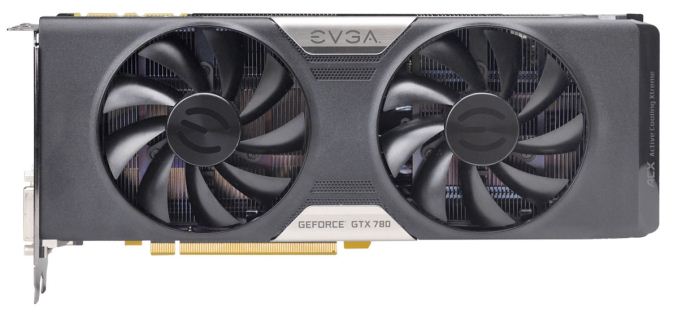








40 Comments
View All Comments
DanNeely - Sunday, September 22, 2013 - link
The HOF being a 3 slot card and being 11.5" long will keep it from fitting in a number of cases.tackle70 - Monday, September 23, 2013 - link
Meh... I don't trust Galaxy's brand/customer support. If I were buying today, I'd take the EVGA Classified.Sabresiberian - Monday, September 23, 2013 - link
Yeah, thanks for calling me a "fool" because I'd rather spend my money (and less of it) with a company whose service is legendary than one that, until recently, was pretty much known for competing only by making a less expensive version.Jodiuh - Tuesday, September 24, 2013 - link
The HOF cards are blowing up on OCN.Oscarcharliezulu - Friday, September 27, 2013 - link
Thx for mentioning that card, it looks amazingDMCalloway - Sunday, September 22, 2013 - link
The HD 7970 GHz used sure is quiet and cool running, and I'm currently using a Red Team card. : )piroroadkill - Sunday, September 22, 2013 - link
nVIDIA took a very human emotional route when naming Titan. There are only so many times within a generation you can give something an amazing name and expect respect. The fact is, the 780 with some extra clock speed can surpass it with less cost.Let's save epic names for cards that utterly surpass the best card by double or more, eh?
piroroadkill - Sunday, September 22, 2013 - link
Just in case you don't know what I mean, ask a lay person, what sounds more awesome: "'seven-eighty' or Titan'". Yeah.inighthawki - Sunday, September 22, 2013 - link
Except that when the Titan came out, the competition was the 680, and it did crush it by quite a margin.jtd871 - Sunday, September 22, 2013 - link
Let's not forget - the ONLY logical reason to buy a Titan is for it's floating point performance. If you're not attempting to build a home supercomputer, then stick with the consumer cards.